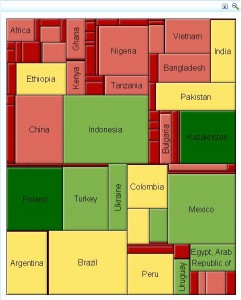Summer in the City: The Analytics Conference in London
This year, we're holding the Analytics conference first in London (June 19-20, Park Plaza Westminster Bridge) and then in Orlando (October 21-22, The Peabody Orlando). It’s a great opportunity to hear how the world's top analysts are putting analytics to work to solve pressing issues facing businesses and other organisations. Ranging from text analysis through to fraud detection, analytics is really changing how our world works.
But have you ever wondered, how do we use analytics to promote the Analytics Conference?
Fluffy Marketers and Hard-Nosed Analysts
As a marketer, I know that marketing often gets bad press, in whatever sort of organisation you work in. I’ve probably heard them all over the years: the colouring in department, the lunch division, the home for retired sales people. Incidentally, I used to work in the training department, so the last one doesn’t quite fit for me. And, of course the adjective ‘fluffy’, something that is soft, furry and billowy. So, we think of an activity which is vague and undefined.
However, marketing actually has to be quite a precise science. In essence, your job as a marketer is to offer a product or service to people who would be interested in buying it, at a price they are prepared to pay. And that’s not fluffy at all, in fact it’s quite hard-nosed and requires a close and honest examination of the information available to you. So, marketing can’t be fluffy, because if it's fluffy it won't work.
Assessing the Size of your Market
There are over 60 million people living in the UK, and – depending how you define it – nearly 740 million people living in Europe. But out of these millions of people, who should you target to attend a conference like Analytics 2013? Actually, the question is simpler than that. How many people are you actually able to target? You have to have some means of contacting them and they have to be contactable, this is termed the total serviceable market.
My role as a marketing manager for the UK and Ireland is to contact my local customers and prospects. So, my first job is to extract a list of them. I know who they are, their job title, who they work for and where they are based. All are relevant factors, only certain types of people use analytics, some companies are more and less likely to send delegates, and for an event in London, people closer to the venue are more likely to attend than those who are further away.
Laying out the Tiles
So, the first step is to segment the target list. The most relevant factor is job title, a ‘business analyst’ is more likely to attend than an ‘ice cream consumption specialist’ not that there are many of them on our list! A good way I’ve found to visualise this is the ‘tile chart’.
A tile chart can be created in many ways in SAS, including PROC GTILE, or using SAS Enterprise Guide, or through data visualization with SAS Visual Analytics. It’s a good way to see how large your segments are, and whether you have too many or too few. You can also quickly see if what you are trying to market has a large enough potential audience to make it viable. If not, how could you expand that audience? As a result, I recommended that we introduced an ‘introduction to analytics’ stream at this year’s event.
London Calling
The the second step in the process, now that we know who to contact is to actually contact them. Targeted communications are much more interesting and less annoying than random ‘spam’, so making sure that you contact the right people is crucial. Also, the price of a call is more than the price of a postcard which costs more than an email. And getting an unwanted call is really annoying, well it annoys me anyway. Analytics and data management is crucial here too. We need to know that the people we are contacting are happy to be contacted, and that they haven’t been contacted very recently.
Measurement and Forecasting
Finally, the success – or otherwise – of our campaign needs to be monitored, measured and forecast. Is it on track? How many people have read and responded to our communications? How many people have actually booked? A combination of these allow us to project the likely result of the event and take any appropriate action to ensure that it is a success.
Analytics for the Analytics Conference
So, I hope you are reassured that we do practice what we preach and make use of analytics to promote our events. But if you’d like to find out even more about how analytics is used in marketing, why not attend the event yourself?

